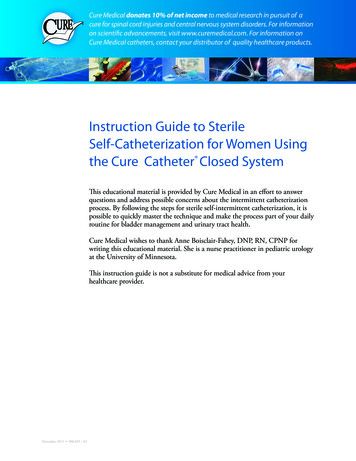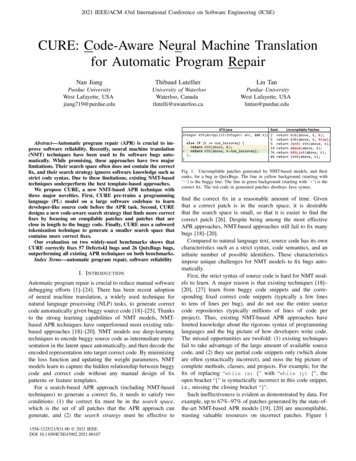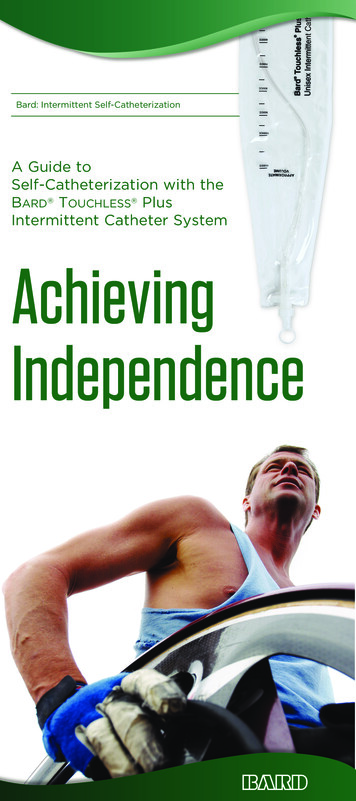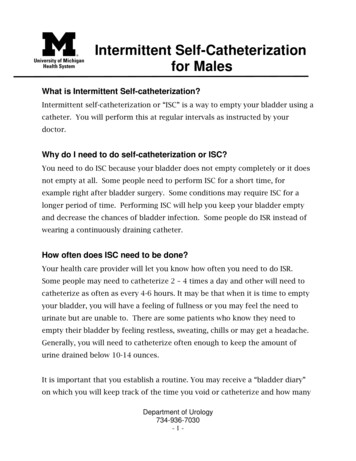
Transcription
Cure Medical donates 10% of net income to medical research in pursuit of acure for spinal cord injuries and central nervous system disorders. For informationon scientific advancements, visit www.curemedical.com. For information onCure Medical catheters, contact your distributor of quality healthcare products.Instruction Guide to SterileSelf-Catheterization for Women Usingthe Cure Catheter Closed SystemThis educational material is provided by Cure Medical in an effort to answerquestions and address possible concerns about the intermittent catheterizationprocess. By following the steps for sterile self-intermittent catheterization, it ispossible to quickly master the technique and make the process part of your dailyroutine for bladder management and urinary tract health.Cure Medical wishes to thank Anne Boisclair-Fahey, DNP, RN, CPNP forwriting this educational material. She is a nurse practitioner in pediatric urologyat the University of Minnesota.This instruction guide is not a substitute for medical advice from yourhealthcare provider.November 2015 900,035 - A2
800.570.1778 www.curemedical.comThe Urinary SystemThe urinary system contains two kidneys, twoureters, the bladder and the urethra. The kidneysfilter the blood and produce urine. The urine travelsfrom the kidneys down the ureters and into thebladder, where it is stored until emptied duringurination or catheterization. The urethra is the tubethat empties the urine out of the body.When the bladder is full, the brain sends a signaldown the spinal cord to the bladder, causing it toempty. For people with spinal cord issues, the signalfrom the bladder to the brain gets interrupted,making them unable to empty their bladder.When people are unable to empty their bladder on their own, they are at risk for urinary tractinfections, as well as incontinence or involuntary loss of urine. When urine stays in the bladderand is not emptied, bacteria can grow, causing infections which can lead to illness. Research hasshown that self-intermittent catheterization helps reduce urinary tract infections, control urinaryleakage (incontinence) and prevent urinary tract damage.Introduction to Self- Intermittent CatheterizationSelf-intermittent catheterization is the periodic emptying of the bladder by the insertion of ahollow plastic tube (catheter) into the urethra, past the sphincter muscle and into the bladder.Urine then passes out of the bladder through the catheter. Self-intermittent catheterization isused when a person is unable to empty her bladder herself. Medical conditions that often requireself-intermittent catheterization include spinal cord injuries, spina bifida or multiple sclerosis,just to name a few. Self-intermittent catheterization must be done at regular intervals each day tokeep the bladder healthy.What is Sterile Self-Intermittent Catheterization?Self-intermittent catheterization is normally performed as a clean technique, meaning glovesare not used, and the catheter can be held with bare, clean hands. However, your healthcareprovider has recommended sterile self-intermittent catheterization to help empty yourbladder, keep your urinary system healthy and reduce urinary tract infections. The key to sterileself-intermittent catheterization is avoiding contact with the catheter; therefore, gloves must beworn and the catheter should go directly from the sterile package into the body withouttouching any surface.
800.570.1778 www.curemedical.comHow Often Should I Catheterize?Your healthcare provider will let you know how often you will need to perform sterileself-intermittent catheterization and the size of the catheter you will need. Normally, sterileself-intermittent catheterization is performed every four hours starting when you wake up inthe morning and continues every four hours until bedtime. Some people catheterize on a morefrequent schedule. Most people who catheterize do not need catheterization at night. Yourhealthcare provider will let you know if you need catheterization at night.Where Do I Get Catheters?You will be taught sterile self-intermittent catheterization by your healthcare provider who willdecide the size and style of catheter that you will need. Your healthcare provider will provide aprescription for the catheter supplies. The prescription will be sent to a medical supply companythat will provide you with the supplies.Sterile Self-Intermittent Catheterization Instructions for WomenMost women who perform sterile self-intermittent catheterization sit on the toilet, a chair orwheelchair when they insert the catheter into the urethra. Other women may perform it lyingdown with pillows behind their backs. Do what is most comfortable for you. Initially you maywant to use a mirror to help visualize the urethral opening where the catheter is inserted. Themirror can be placed on a low stool in front of the toilet seat. It may take time for you to locatethe proper opening. Eventually most women learn to catheterize by touch and feel.1. Inspect Cure Catheter Closed System before use. If catheter or package is damaged do not use.The sterile, unisex Cure Catheter Closed System is not made with DEHP, BPA, or naturalrubber latex. It features polished eyelets on a straight, pre-lubricated catheter tip withintegrated 1500ml collection bag.2. Wash hands thoroughly with soap and water or an antibacterial hand cleaner.3. Open the Cure Catheter Closed System kit.
800.570.1778 www.curemedical.comSterile Self-Intermittent Catheterization Instructions for Women continued4. Position yourself comfortably. Arrange clothingout of the way. If sitting in a chair or wheelchair,spread your legs apart and place the underpad onthe chair. If lying down, bend knees and placeyour heels together in a “frog-like” position(shown) on the underpad provided in the kit.5. Put on the gloves provided in the kit. Open thepovidone-iodine swabsticks or BZK wipeprovided in the catheter kit.6. Using the non-dominant hand, separate thelabia with the thumb and forefinger to locatethe urethra.7. With the labia separated, wash the urethral area from front to back thoroughly with apovidone-iodine swabstick or the BZK wipe. Never go back and forth over the urethralopening. Repeat washing from front to back with the other two swabsticks or two differentareas of the BZK wipe. Discard the swabsticks or wipe when you are finished.8. Remove the cap from the introducer tip and slide the catheter to within 1/8” (2 mm) ofthe top of the silicon tip. DO NOT slide the catheter past the introducer tip yet.9. With the non-dominant hand hold innerlabia apart, use the dominant hand to insert theintroducer tip into the urethra. Secure it in placewith thumb and forefinger of the non-dominanthand. Use the dominant hand to grasp thecatheter through the bag close to the base ofthe introducer shaft.10. Slowly push the catheter through the introducertip and into the urethra. Continue to slide itthrough the urethra about 2 inches until thecatheter reaches the bladder and urine begins toflow.
800.570.1778 www.curemedical.comSterile Self-Intermittent Catheterization Instructions for Women continued11. When urine stops flowing, slowly rotate the catheter through the bag between your fingerswhile withdrawing the catheter. If urine starts to flow again when withdrawing the catheter,stop each time it flows and let the urine drain. Continue to slowly withdraw the catheteruntil the bladder is empty and the catheter is removed.12. To empty the bag, hold it upright and put your thumb in the holeprovided at the top of the bag (shown right). Grasp the tab and teardownwards at the perforation located above “To Empty Tear Here”.Pour out the urine through the opening into the toilet. Dispose of thebag properly.
800.570.1778 www.curemedical.comYour Sterile Self-Intermittent Catheterization Specifications:·Cure Catheter Closed System size:n 8 FR n 10 FR n 12 FR n 14 FRn 16 FR·Catheterize times a day or every hours.·Catheterization required at night:n Yesorn NoHealthcare provider contact information:Name Telephone NumberHealthcare product supplier contact information:Name Telephone Number
The sterile, unisex Cure Catheter Closed System is not made with DEHP, BPA, or natural rubber latex. It features polished eyelets on a straight, pre-lubricated catheter tip with integrated 1500ml collection bag. 2. Wash hands thoroughly with soap and water or an antibacterial hand cleaner. 3. Open the Cure Catheter Closed System kit.










